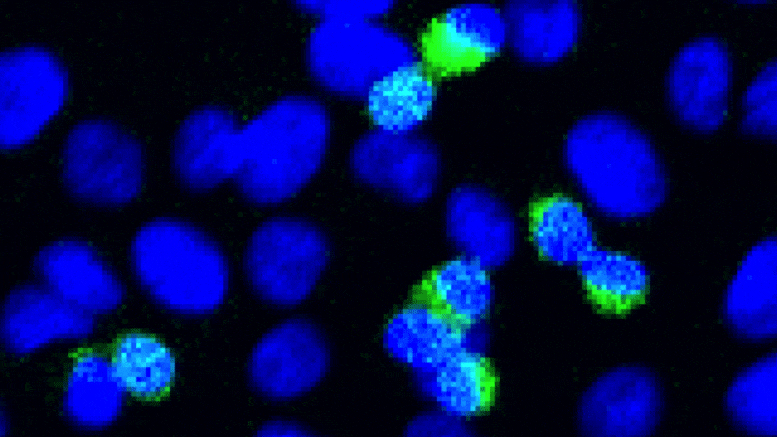Scientists Discover a Novel Defense Mechanism Against the COVID-19 Coronavirus
0 View
Share this Video
- Publish Date:
- 19 June, 2021
- Category:
- Covid
- Video License
- Standard License
- Imported From:
- Youtube
Tags

SARS-CoV-2 replication is suppressed by RIG-I. When lung cells not expressing RIG-I (left) are exposed to SARS-CoV-2, viral spike proteins (green) are detected as early as 5 days (72 hours) after exposure. In normal cells (right), SARS-CoV-2 replication is suppressed (Taisho Yamada, et al. Nature Immunology. 11 May 2021). Credit: Taisho Yamada, et al. Nature Immunology. May 11, 2021
Scientists at Hokkaido University have discovered a novel defensive response to SARS-CoV-2 involving the viral pattern recognition receptor RIG-I. Upregulating the expression of this protein could enhance the immune response in COPD patients.
In the 18 months since the initial report of COVID-19 and the spread of the pandemic, there has been a great deal of research into understanding it and developing treatments to treat it. COVID-19 does not affect all infected individuals equally. Many people are asymptomatic; of those who are symptomatic, the great majority have mild symptoms and only a small number have severe cases. The reasons for this are not fully understood and are an important area of ongoing research.
A team of scientists from Hokkaido University, led by Professor Akinori Takaoka of the Institute for Genetic Medicine, has shown that RIG-I, a biological molecule that detects RNA viruses, inhibits SARS-CoV-2 replication in human lung cells. . Their findings, which could help predict outcomes in COVID-19 patients, were published in the journal Nature Immunology.
To date, more than 162 million people have been affected by COVID-19. About 40% – 45% of these individuals are asymptomatic; for the rest, about 35% – 40% had a mild form of the disease, while the remaining 19% were affected by symptoms severe enough to warrant hospitalization or were fatal, which are commonly associated with comorbidities and risk factors such as chronic obstructive pulmonary disease (COPD). This range of symptoms indicates that there are large differences between individual responses to the virus.
Taisho Yamada (left), lead author, and Akinori Takaoka (right), communicating author of the article. Credit: Taisho Yamada, Akinori Takaoka
Microbial pathogens in our body are detected by proteins called pattern recognition receptors (PRRs), which also trigger immune responses to these pathogens. Viral infections are detected by a subset of PRRs; the scientists turned their attention to the protein RIG-I, which belongs to this subset. RIG-I is known to be crucial for the detection and response to RNA viruses such as the influenza virus.
In experiments conducted in cell culture lines, the scientists found that there was little innate immune response to SARS-CoV-2 in lung cells, suggesting that the signaling pathway leading to immune response had been disrupted. Nevertheless, viral replication was suppressed. The scientists examined the role of RIG-I and found that its deficiency caused increased viral replication. Further experiments confirmed that the suppression of viral replication was dependent on RIG-I.
A single previous study has shown that RIG-I expression is downregulated in lung cells of COPD patients. Using primary lung cells from two COPD patients, the scientists showed that this down-regulation of RIG-I resulted in the detection of viral replication after 5 days. They also showed that treatment of these COPD cells with all-trans retinoic acid (ATRA), which upregulates the expression of RIG-I, significantly reduced viral titers in the cells. In addition, using RIG-I mutants, they were able to elucidate the mechanisms by which RIG-I suppressed SARS-CoV-2 replication: the helicase domain, a structural element in RIG-I, interacts with the viral RNA and blocks a virus-derived enzyme. which is responsible for replication.
This study has demonstrated a unique viral recognition mode of RIG-I, the RIG-I mediated signaling-abortive anti-SARS-CoV-2 defense mechanism. It has also indicated that RIG-I expression levels are one of the possible parameters for the prediction of the outcomes of COVID-19 patients. Efforts continue to uncover factors or conditions that modulate RIG-I expression levels and may lead to novel strategies to control SARS-CoV-2 infection.
Reference: “RIG-I Triggers a Signaling Abortive Anti-SARS-CoV-2 Defense in Human Lung Cells” by Taisho Yamada, Seiichi Sato, Yuki Sotoyama, Yasuko Orba, Hirofumi Sawa, Hajime Yamauchi, Michihito Sasaki and Akinori Takaoka, 11 May 2021, Natural Immunology.
DOI: 10.1038/s41590-021-00942-0










